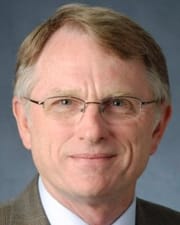 Progress on the Central District Development Project is increasingly visible at Kansas University. The $350 million project is transforming a 45-acre space that lies north and east of the Iowa and 19th Street into “Innovation Way.” Financing was completed and construction began in January 2016.
Progress on the Central District Development Project is increasingly visible at Kansas University. The $350 million project is transforming a 45-acre space that lies north and east of the Iowa and 19th Street into “Innovation Way.” Financing was completed and construction began in January 2016.
Jim Modig, University Architect and Director of Design and Construction Management (DCM) at KU, took care to describe the scope and history of the project in his presentation to the club. The project is the tangible result of KU’s Master Plan for 2014-2024. In particular, that plan recognized that existing spaces for science classes at KU were suffering from delayed maintenance and were too small, unsafe, and outdated to attract the best students.
The scope of the Central District Development work includes creating Jayhawk Trail that will tie the campus together end-to-end with accessible access for pedestrians and bicyclists. A new Integrated Sciences building is designed to encourage innovation and collaboration among students of various scientific disciplines. A new student union with flexible conference space, a parking garage for 600 cars, a new central utility plant, new apartments, and a new residence hall with dining facility are also part of the plan. The images of the residence hall in time lapse photographs reveal the speed of the work.
Companies from all over the world expressed interest in bidding on this project, Modig said, but after reviewing the qualifications of those companies, the project team asked for a Request for Proposal (RFP) from three firms. The RFPs addressed building of the science facilities, modernizing the campus infrastructure, providing student housing, and addressing ongoing operations and maintenance.
The Central District Development Project has been financed through a public/private partnership (P3), a non-profit entity that ensures that the State and the Board of Regents are not liable for the debt.
The economic impact of the Central District Development Project is significant, according to Modig. The project employs more than 8,500 people directly and indirectly. For every $1 spent, the project generates $2.47 in incremental economic value. Seventy-five percent of the subcontractors for the projects underway have been awarded to Kansas-based businesses; another 20% have gone to companies in the Kansas City area; only 5% have been given out-of-state.